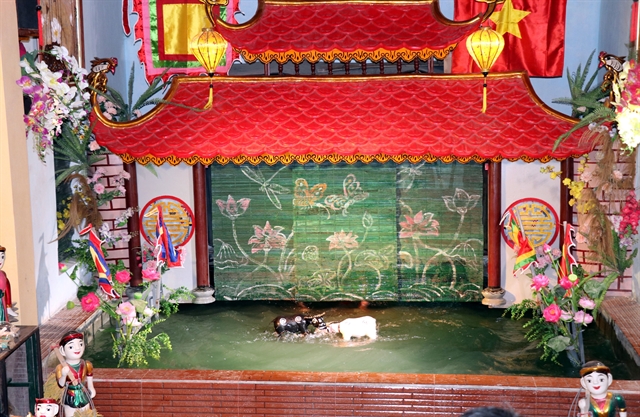 Features
Features
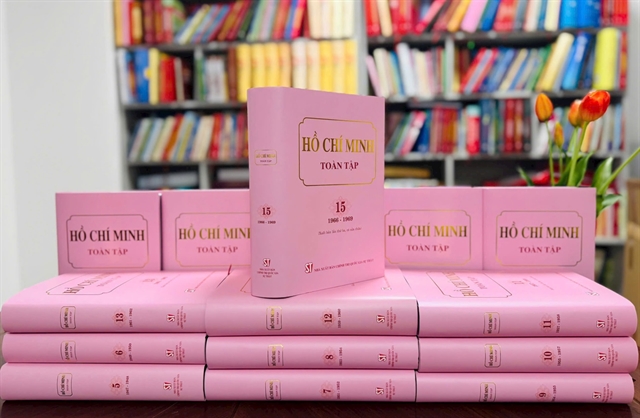
The fine strands that can be extracted from the delicate lotus flower have the potential to be combined with the silk produced by worms. Lê Hương & Hồng Vân report.
 |
| Fine: Phan Thị Thuận extracts cellulose string from lotus stems. VNS Photo Hồng Vân |
The fine strands that can be extracted from the delicate lotus flower have the potential to be combined with the silk produced by worms. Lê Hương & Hồng Vân report.
On a bright day in a tranquil village by the Đáy River about 50km from Hà Nội, a silkworm workshop is full of life.
Thousands of silkworms are secreting tiny clear thread of silk “working” on a flat mat within wooden frames to make natural silk blankets.
By a window looking over the river, Phan Thị Thuận, the owner of the workshop, is working on an experiment – weaving fabric from "lotus silk". Over her 40 years in the industry, Thuận has become well-known for weaving natural silk into unique blankets.
Carefully holding several lotus stems in her hands, Thuận lays them neatly on her desk.
Using a small knife, she gently makes a cut in each of the stems, which then opens to pull out a small amount of cellulose thread from the cuts. Using water, her skilful fingers arrange the threads, which will be used later to weave lotus "silk" fabric.
“The idea was actually proposed to me by Trần Thị Quốc Khánh, a member of the National Assembly representing Hà Nội,” Thuận told Việt Nam News.
Khánh and some scientists from the Hà Nội-based Institute for Ecological Economics initiated a national-level project of producing silk from lotus.
Khánh encouraged Thuận to go to Cambodia and Myanmar to learn about weaving "lotus silk", but Thuận insisted she would try it by herself, then go later.
 |
| Success: Thuận poses for a photo with a scarf made of lotus silk. The scarf has a distinctive lotus scent. VNS Photo Hồng Vân |
Her village has many lakes and ponds with abundant lotus flowers. Since January 2017, Thuận has tried various ways to extract the most thread from lotus stems.
“The stems from mature lotus flowers offer the strongest and most beautiful thread, but if they are too old the thread is difficult to extract and cut,” she said.
After many failed attempts, Thuận finally succeeded in making a scarf from "lotus silk" with a distinctive scent.
“Silk from lotus stems is softer and more flexible than silk from worms,” she noted. “It doesn’t shrink as much as silk from worms, but in my experience, ’lotus silk’ doesn’t last as long.”
Thuận says that when she puts lotus silk into water, it starts to wrap around her hands.
A silk worm eats mulberry leaves for 20 days, then it secretes silk threads to form a silk nest (cocoon) surrounding its body.
The cocoon should be boiled before the silk is removed for weaving.
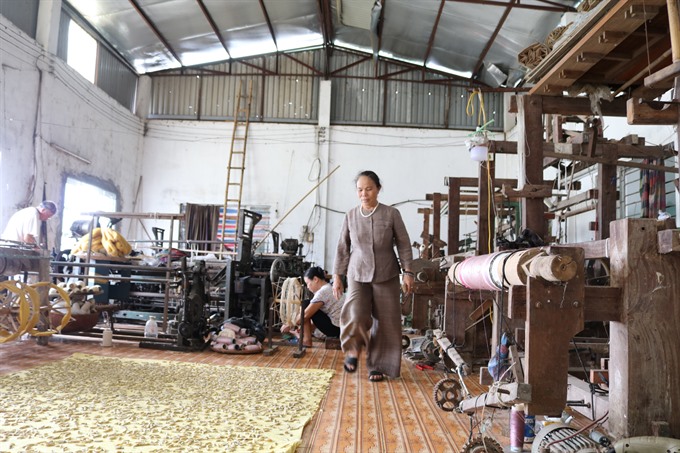 |
| Workforce: Thuận’s workshop where thousands of silkworms "weave" natural silk blankets by themselves. VNS Photo Hồng Vân |
“Skilled workers can extract ’lotus silk’ from 260 stems per day to produce about 175m of thread,” she said, “Depending on its thickness, a scarf made from ’lotus silk’ requires at least 1,500 stems.”
The intensive labour results in high costs.
“I think if I mix lotus and worm silk, I can produce a new mixed silk for a lower cost that lasts for longer than pure ’lotus silk’,” Thuận said. "But I need more time to confirm that."
“If we had a market for ’lotus silk’ fabric, it would be easier for me to develop this new kind of ’silk’ and create more jobs,” Thuận said.
After she completed her first scarf last year, Thuận took a trip to Cambodia to visit some ’lotus silk’ workshops.
“I realised that their products were no better than mine,” she said. “I can do better.”
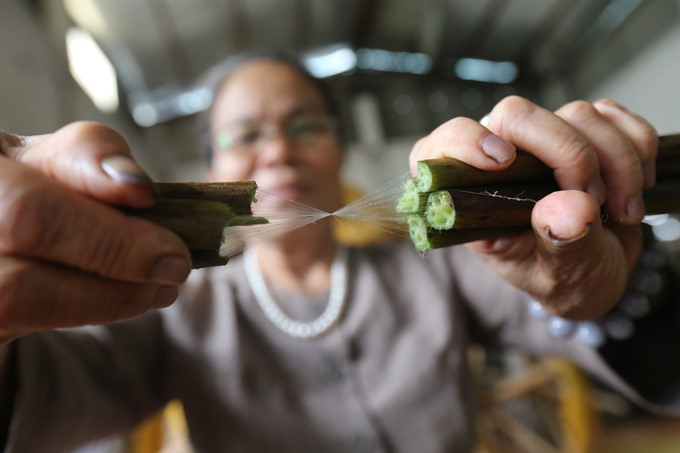 |
| Valuable: Lotus silk is as fragile as smoke but it’s quite valuable as it takes so much work. VNS Photo Việt Cường |
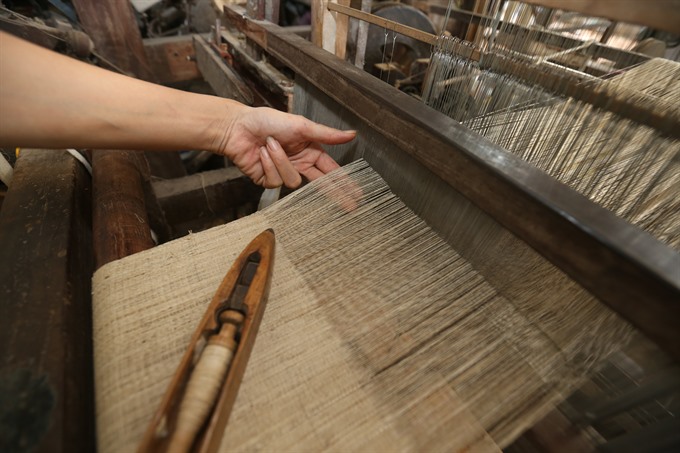 |
| Delicate: Silk from lotus is softer and more flexible than silk from worms. VNS Photo Việt Cường |
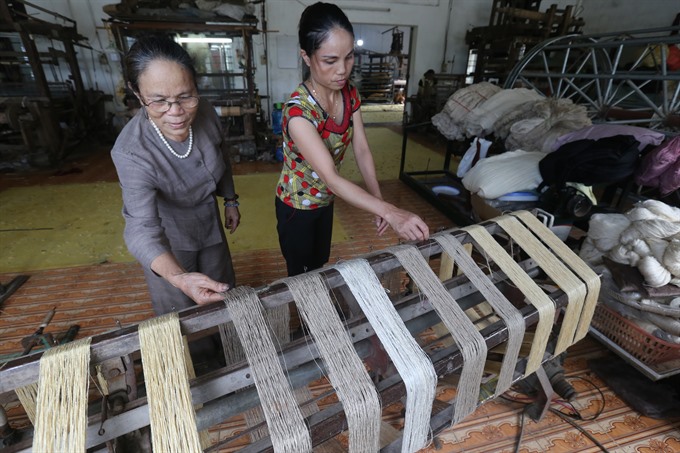 |
| Long haul: Skilled workers can get 175m of thread per day. VNS Photo Việt Cường |
National-level project
What Thuận has been doing is in the framework of a project run by the Institute for Ecological Economics under the Union for Science and Technology Associations.
“We proposed the project as a national trial model to produce silk from lotus flowers funded by the State budget for the Council of National Projects,” said Nguyễn Duy Chuyên, director of the institute.
Then our experts took a field trip to Myanmar to see how they weave "lotus silk" cloth.
We chose Thuận’s silk workshop in Mỹ Đức District as a trial model in the north as she has become an artisan in silk and could quickly find out the best way to get silk from lotus stems, he said.
According to a research paper by Hà Chu Chử, Nguyễn Thị Minh Tâm and Đình Thị Minh from the institute, based on the availability of lotus flowers in Việt Nam, the country has great potential for producing ’lotus silk’.
Their research also found that humidity affects the flexibility of ’lotus silk’.
“The research will be useful to adjusting the process of planting lotus and collecting silk from lotus stems,” Chuyên said.
“We will co-operate with the Textile and Garment Institute to research and judge the quality of silk from Vietnamese lotus stems and propose ways to enhance the quality and reduce the cost,” Chuyên said.
Experts will then apply other technology to the weaving and dyeing processes to increase the value of ’lotus silk’.
Chuyên said next year, the project will move to Đồng Tháp Mười (Plain of Reeds in the Mekong Delta), which is home to the largest area of various lotus species in the country.
“’Lotus silk’ is as fragile as smoke but it’s quite valuable as it takes so much labour,” Thuận said. “It’s like a gift from Mother Nature.”
“I hope designers will think about using ’lotus silk’ in high fashion products other than just plain clothes,” she added. VNS




